Exploring the Validity of Tarot Cards: Do They Work?
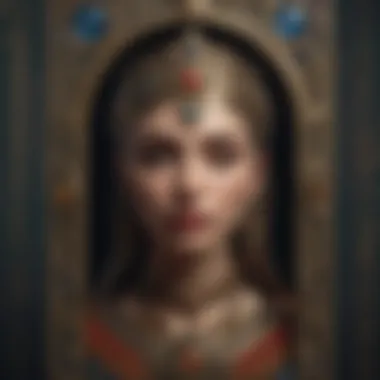
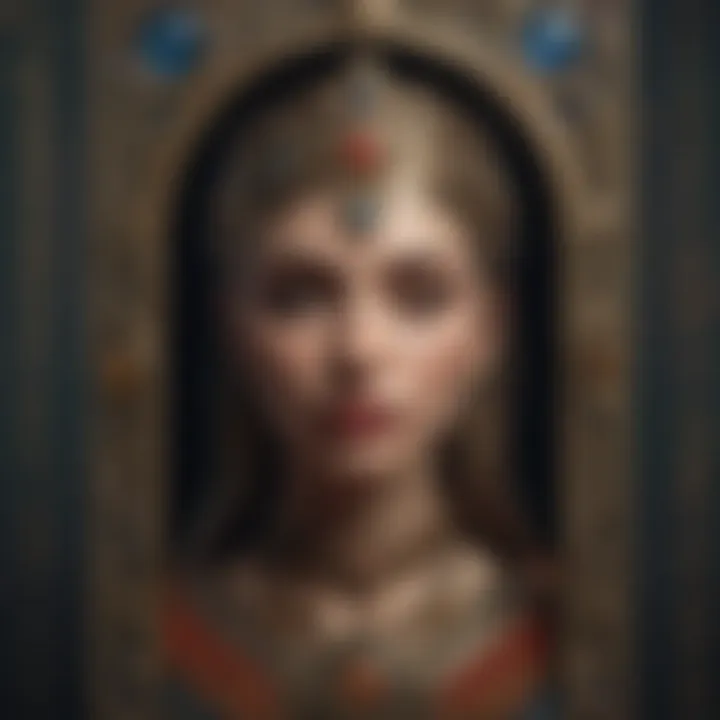
Intro
The realm of tarot cards ignites fascination and skepticism in equal measure. For centuries, enthusiasts have turned to these cards in search of guidance and insight into their lives. While some dismiss tarot as mere superstition, a growing body of individuals finds profound meaning and clarity through its practice. This article seeks to dissect the intricacies of tarot, exploring its historical background, psychological effects, and cultural significance.
By examining the mechanics of tarot readings and assessing both anecdotal evidence and empirical studies, we can better understand how tarot fits into our contemporary context. Can these cards genuinely provide insights, or are they just a means for self-reflection? This investigation not only serves as an informative guide for novices but also offers critical analysis for seasoned practitioners, contributing to the discourse on tarot's validity.
Historical Context of Tarot Cards
The history of tarot cards dates back to the 15th century in Europe. Initially, they were created for entertainment, rather than divination. This divergence began in the 18th century when figures like Antoine Court de Gébelin began to associate tarot with ancient Egyptian lore and mysticism. Tarot's entwinement with the occult led to its modernization and the creation of various decks, each with unique illustrations and interpretations.
As the practice evolved, tarot became a popular tool for introspection. People sought to understand their lives through the symbolism represented on the cards. This historical context highlights the adaptability of tarot, showcasing its transition from a card game to a profound spiritual tool.
Psychological Aspects of Tarot Reading
Tarot readings often hinge on psychological principles, where the cards serve as prompts for reflection. When individuals engage in a reading, they project their thoughts and feelings onto the cards. This phenomenon is comparable to the concept of free association in psychology. The interpretation of each card can unveil unconscious patterns and connections in a person's life.
For many, the act of shuffling the cards and laying them out can be therapeutic. It provides a moment of calm and focus, allowing them to confront their emotions and challenges. In this way, tarot does not necessarily predict the future; instead, it fosters greater self-awareness and clarity.
"Tarot cards act as a mirror, reflecting one's inner thoughts, fears, and desires."
Cultural Significance of Tarot Today
In contemporary society, tarot has solidified its place within various spiritual practices. It intersects with trends toward holistic living and self-exploration, embraced by astrology enthusiasts and those seeking alternative approaches to life. Many view tarot as a complementary tool alongside practices such as meditation and mindfulness.
The rise of social media and online platforms has enabled the sharing of tarot practices, making it more accessible. Communities on platforms such as Reddit and Facebook discuss techniques, interpretations, and experiences, creating a shared space for learners and practitioners alike.
This cultural shift allows tarot to transcend traditional boundaries, appealing to a diverse audience while retaining its core function of fostering introspection and insight.
End
In sum, exploring the validity of tarot cards entails a multi-faceted examination of their history, psychological impact, and cultural relevance. While skepticism may remain, many individuals find value in the insights provided by tarot readings. By understanding the mechanics behind tarot, one can appreciate its potential as a tool for self-discovery and personal growth.
Prologue to Tarot Cards
The exploration of tarot cards offers a significant pathway toward understanding their perceived power and cultural footprint. This section is pivotal as it lays the groundwork for what tarot truly represents in both historical and modern contexts. Tarot cards are more than simple divination tools; they serve as a reflection of psychological states and philosophical inquiries. Understanding their definition and origin sheds light on their intended purpose, drawing readers into a nuanced study of what tarot can represent.
Definition of Tarot Cards
Tarot cards are a set of 78 cards that are used for divination and introspection. They are divided into two main segments known as the Major Arcana and the Minor Arcana. The Major Arcana consists of 22 cards, each symbolizing significant life events or spiritual lessons. The Minor Arcana is made up of 56 cards, further split into four suits that represent daily challenges and experiences. Generally, the cards are interpreted based on their imagery and positions in a spread during a reading.
Brief History of Tarot Origin
The origins of tarot are rooted in the 15th century in Europe, primarily in Italy. Initially, tarot was used as a playing card game, known as tarocchi, rather than a tool for divination. Over time, the cards became imbued with mysticism. In the late 18th century, the usage of tarot for divination was established, particularly in France and later spread throughout Europe and America. Influences from various cultural practices contributed to the evolving nature of tarot, leading to an array of interpretations and decks that resonate with contemporary audiences. This historical perspective is crucial, as it shows the transformation of tarot from a simple entertainment medium to a complex instrument for personal insight.
Understanding the roots of tarot can enhance one’s appreciation for its depth and multifaceted nature.
Mechanics of Tarot Reading
Understanding the mechanics of tarot reading is central to comprehending how tarot functions as a tool for insight and decision-making. This section investigates the components that make up the tarot reading process. It focuses on the structural elements of a tarot deck and the various spreads used during readings. These aspects are essential for anyone looking to deepen their knowledge about tarot's practical applications.
Structure of a Tarot Deck
A standard tarot deck typically consists of 78 cards. These are divided into two main categories: the Major Arcana and the Minor Arcana.
- Major Arcana: The 22 cards here represent significant life events or spiritual lessons. Each card conveys deep meanings and is often seen as pivotal in readings. For example, cards such as The Fool and The Tower denote change, beginnings, and endings.
- Minor Arcana: This part comprises 56 cards, reflecting day-to-day events. It is divided into four suits: Cups, Wands, Swords, and Pentacles. Each suit relates to different life aspects.
- Cups: Often linked with emotions and relationships.
- Wands: Associated with creativity and action.
- Swords: Relate to thoughts and conflicts.
- Pentacles: Represent material aspects and career.
The combination of these two sections provides a comprehensive overview of the human experience, making tarot a multifaceted tool for readings.
Common Tarot Spreads
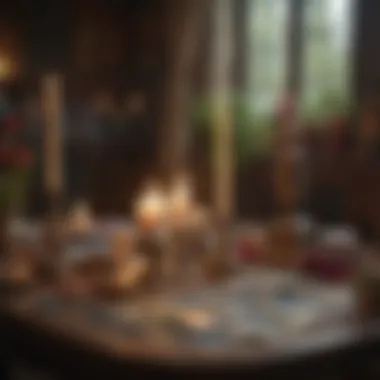
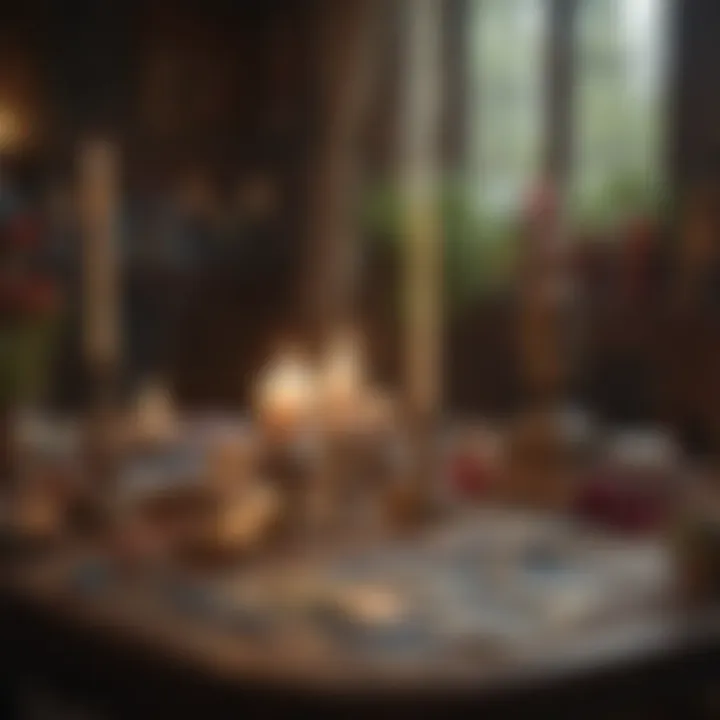
Tarot spreads refer to the layout of cards during a reading. Each spread serves a unique purpose and can affect the interpretative framework. Common spreads include:
- Three-Card Spread: This is a basic yet popular spread. The three cards usually represent the past, present, and future aspects of a question or situation.
- Celtic Cross Spread: This spread is more complex, consisting of ten cards. It offers insights into various dimensions of a situation by highlighting challenges, influences, and immediate outcomes.
- One-Card Draw: This is used for a quick insight or affirmation. It's a straightforward approach ideal for daily guidance.
Using the appropriate spread helps focus the reading and clarifies the questions being asked. Choosing the right layout can enhance the depth of the interpretation, allowing for a more nuanced understanding of the querent's inquiries.
"The essence of tarot lies not only in its cards but also in how they are laid out and interpreted, giving each reading a unique frame of reference."
In summary, the mechanics of tarot reading encompass both the structure of the deck and the various spreads. Concentrating on these elements can substantially enhance the effectiveness of a reading, offering clearer insights to those who seek them.
Psychological Aspects of Tarot
Understanding the psychological aspects of tarot cards is essential in evaluating their potential effectiveness and relevance in contemporary society. Tarot readings often serve not only as potential tools for divination but also as instruments for introspection and personal growth. Engaging with tarot can help individuals tap into deep-seated emotions and thoughts, making the intricacies of human psychology a key area to explore. This section considers how cognitive biases influence interpretations and the role of intuition in tarot reading.
Cognitive Bias and Interpretation
Cognitive bias is a natural inclination of the human mind to think in certain ways, which often leads to systematic deviations from a standard of rationality or good judgment. In tarot reading, these biases can heavily shape how individuals interpret the cards drawn. For instance, confirmation bias causes people to favor information that confirms their existing beliefs while disregarding evidence that contradicts them. This can make readings appear more accurate than they might objectively be.
Additionally, subjective interpretations can vary widely among different readers and querents. What one person precieves as a sign of bad luck, another may see as an opportunity for growth. This variance is driven by personal experiences and beliefs, demonstrating how bias can skew the potential meanings of the cards. Thus, when engaging in tarot reading, it is important to be aware of how personal biases may influence understanding and decisions based on the reading.
An awareness of cognitive biases can lead to more thoughtful and reflective readings, allowing a person to navigate their emotions and thoughts with greater clarity. It may also encourage individuals to approach tarot not just as a predictive tool but as a medium for self-exploration and understanding.
The Role of Intuition
Intuition plays a significant role in the tarot reading process. It is that instinctual knowledge that comes from within, often without conscious reasoning. Many tarot practitioners often describe their skill as being highly reliant on intuition to interpret the cards. This reliance raises the question of how intuition contributes to the perceived validity of tarot readings.
When a reader allows intuition to guide them, the session can evolve beyond mere card meanings. A seasoned reader may notice unexpected patterns or intuit meanings that are not overtly described in traditional tarot lore. This subjective element adds depth to readings, making them uniquely personal to both the reader and the querent.
Additionally, intuition can foster a greater connection to a deeper sense of self. For those seeking guidance or insight, trusting one's intuition during a tarot session can be empowering, promoting further self-dialogue. This can lead to deeper understanding and internal clarity regarding life choices, relationships, and personal challenges.
Cultural Perspectives on Tarot
Understanding the cultural perspectives on tarot is crucial in assessing its validity and relevance across different societies. Tarot cards are more than mere tools for divination; they are also profound cultural artifacts, reflecting the nuances of societal beliefs, rituals, and contexts. Each culture incorporates tarot in ways that both enrich and diversify its practice. This examination allows for a broader appreciation of how tarot serves varied communities and highlights the effectiveness attributed to it in distinct cultural settings.
Tarot in Western Culture
In Western culture, the tarot has evolved significantly from its origins as a card game in the 15th century. The 18th century saw tarot emerge as a tool for mysticism and divination, largely influenced by the occult movements of the time. This transformation led to the popularization of decks such as the Rider-Waite-Smith Tarot, which has become a staple in tarot reading.
The imagery and symbolism used in tarot cards appeal to many by drawing on archetypes found in mythology and psychology. Carl Jung’s concept of archetypes has informed how tarot readings can be viewed as a process of self-discovery and insight. A typical reading in Western practices often focuses on personal issues, emotional states, or life questions, reflecting individualism at its core. This perspective makes tarot a popular choice among those seeking personal growth and a deeper understanding of their circumstances.
Key Elements of Tarot in Western Culture:
- Individualism: Tarot readings are often personal, allowing for subjective interpretations.
- Psychological Insight: The use of archetypes aligns with psychological explorations of self.
- Cultural Symbolism: The cards often contain symbols that resonate with Western historical and spiritual backgrounds.
Global Variations of Tarot Practices
Globally, tarot practices vary widely, each bringing unique elements that reflect regional beliefs and traditions. In some cultures, tarot is intertwined with other spiritual practices, like astrology or shamanism, creating a hybrid approach to divination.
In Latin America, tarot may be used alongside indigenous beliefs, leading to a blend of symbolism and interpretation methods that diverge from Western practices. Similarly, in Asian cultures, tarot might integrate with practices like Feng Shui or local spiritual rituals. This adaptation reveals the flexibility of tarot as a practice that is not confined to a single ideology.
Variations in Global Tarot Practices Include:
- Cultural Integration: Local beliefs shape how tarot is interpreted and used.
- Hybrid Tools: Tarot is often used in conjunction with other divination methods.
- Community Focus: In many cultures, tarot readings are communal experiences, fostering collective insights.
Understanding these cultural perspectives is vital to comprehending the broader implications of tarot. By recognizing how different societies interpret tarot, one can appreciate its role beyond mere fortune-telling. It becomes a mirror reflecting the values, beliefs, and fears of the culture utilizing it.
Anecdotal Evidence vs. Empirical Studies
The exploration of tarot cards requires a balanced look at both anecdotal evidence and empirical studies. These two elements play a critical role in understanding the potential efficacy of tarot. While personal experiences can provide meaningful insights, they often lack the systematic rigor of scientific methods. The importance of this topic lies in bridging subjective interpretation with objective analysis. Anecdotal evidence may draw emotional resonance, and it serves as a foundation for many people's beliefs about tarot. Conversely, empirical studies provide the necessary framework to either support or challenge these beliefs through controlled research and measurable results.
Personal Testimonials
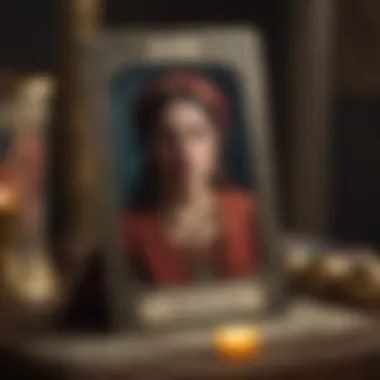
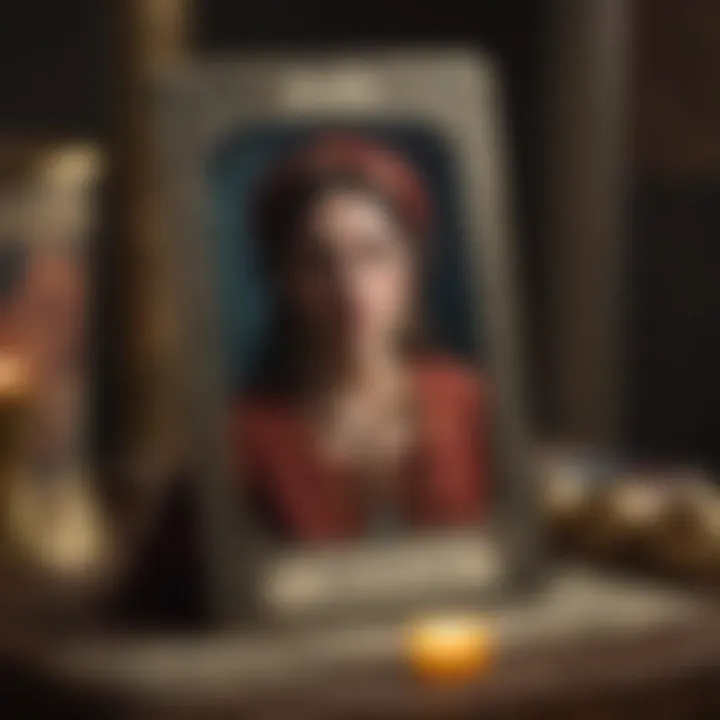
Personal testimonials offer rich narrative accounts of how individuals perceive the impact of tarot readings in their own lives. Many people share transformative experiences after a reading, claiming that the insights gained helped clarify their thoughts or influenced significant life decisions. These stories can provide powerful affirmation for practitioners and seekers alike. Here are several key points about personal testimonials:
- Subjectivity: Each person's interpretation varies widely. What resonates with one individual may not have the same relevance for another.
- Cognitive Effects: The placebo effect can often come into play. Believing in the guidance from tarot may lead to actual changes in behavior or mindset.
- Cultural Significance: Personal stories often reflect broader cultural themes. For instance, the popularity of tarot in various cultures can offer clues about its perceived role and significance in those societies.
Though compelling, personal testimonials should be approached with caution, as they do not constitute scientific proof.
Scientific Studies on Tarot Efficacy
In contrast to personal testimonials, scientific studies aim to provide more standardized insights into the effectiveness of tarot cards. Researchers often explore the psychological mechanisms behind tarot readings. Some studies have found correlations between tarot use and improved self-reflection or decision-making processes. Here are some notable aspects:
- Research Design: Empirical studies typically utilize control groups and randomized assignments, yielding results with greater reliability.
- Measurement of Outcomes: These studies may assess specific psychological outcomes such as anxiety reduction, clarity in decision-making, or personal growth.
- Skepticism and Critique: While some studies support the utility of tarot, skeptics may point out methodological flaws or lack of reproducibility in findings.
Overall, scientific research provides a necessary counterbalance to anecdotal evidence, allowing for a more comprehensive understanding of tarot's place in personal and psychological wellness." >
"While personal experiences can be deeply compelling, they must integrate with empirical evidence to build a well-rounded perspective on the efficacy of tarot."
Both anecdotal and empirical evidence contribute valuable perspectives in the dialogue regarding tarot cards. Proper balance and consideration of each can help elucidate whether tarot truly works as a tool for insight.
Practical Applications of Tarot Cards
The discussion around practical applications of tarot cards is significant. It encompasses how individuals interact with tarot in their lives and the diverse outcomes of these experiences. The validity of tarot often hinges on its ability to serve as a tool for navigation through complexities of life, and this section dives deep into two main facets: self-reflection and integration with other practices.
Tarot as a Tool for Self-Reflection
Tarot cards function as a mirror, reflecting the querent’s current state of mind and emotional landscape. Engaging with a deck encourages introspection and fosters a deeper understanding of oneself. When individuals draw cards, they confront their thoughts, feelings, and situations from different angles. This can lead to a heightened awareness of unconscious patterns or unaddressed concerns.
The act of interpreting cards can also invoke curiosity, prompting individuals to ask probing questions such as:
- What do my choices reveal about me?
- Am I aligning with my true values?
These questions may not have clear answers, yet the process of grappling with them stimulates personal growth. Many find that tarot readings illuminate paths they had previously overlooked, assisting them in decision-making processes. This self-reflective aspect positions tarot as a valuable companion in personal development journeys.
"Self-reflection can unveil hidden truths and provide clarity that is often elusive in day-to-day life."
Integration with Other Practices
Tarot's potential is further amplified when used alongside other holistic practices. Whether paired with meditation, journaling, or mindfulness exercises, tarot offers unique insights that can enhance these activities. For example, someone might use tarot cards to inspire journal prompts or to deepen the focus during meditation sessions. This integration can create a more holistic approach to personal exploration.
Several practitioners emphasize the benefits of combining tarot with:
- Astrology: Understanding personal planetary influences can be supplemented by tarot cards, aligning energies and themes.
- Crystal Healing: Specific crystals can resonate with particular cards, enhancing the overall experience.
- Life Coaching: Coaches may employ tarot readings as a tool to help clients uncover their goals and blockages.
This cross-disciplinary use highlights tarot's adaptability and reinforces its utility beyond mere divination. Readers are encouraged to explore blending tarot with their preferred methods, cultivating a richer, more nuanced experience.
In summary, the practical applications of tarot cards are vast. Whether serving as a catalyst for self-reflection or merging seamlessly with other practices, tarot provides tangible benefits that can significantly enrich the user's journey. Engaging with tarot in these ways invites participants to cultivate a mindful approach to their lives, leading to deeper understanding and connection.
Common Misconceptions about Tarot
The topic of common misconceptions about tarot plays a vital role in understanding how tarot cards are perceived and utilized within various communities. Misinterpretations can lead to skepticism or an undue romanticization of tarot practices. Therefore, it is essential to address these misconceptions. By clarifying what tarot is and what it is not, individuals can approach tarot readings with more informed perspectives.
Accurate understanding fosters better experiences with tarot. It encourages seekers to use tarot cards as a genuine tool for self-reflection rather than as mere fortune-telling devices. In turn, this can lead to beneficial outcomes both for the querent and the reader.
Debunking Myths
Many myths surround tarot cards. One prevalent myth is that tarot cards predict the future. This notion can create unreasonable expectations for users. While tarot can provide insights into potential future outcomes based on current trajectories, it does not serve as an irrefutable guide to what will definitively happen. The cards reflect a specific moment and context, helping individuals to think critically about their choices and circumstances.
Another myth is that tarot cards possess innate powers. The truth is that the power lies with the user. The interpretation is subjective. Cards are symbols, and their meanings can reflect the querent’s inner thoughts, emotions, and concerns. The efficacy of a reading heavily relies on the skills and intuition of the reader.
Misunderstanding Tarot's Purpose
The purpose of tarot is frequently misrepresented, leading some to consider tarot purely as a mystical or esoteric tool. However, this view overlooks its capacity for self-exploration and personal growth. Tarot can act as a mirror, reflecting an individual’s thoughts and feelings. It serves as a guide for introspection, making it particularly valuable in times of uncertainty.
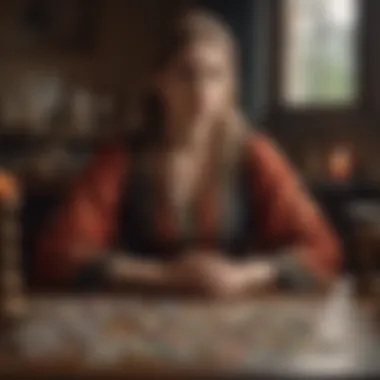
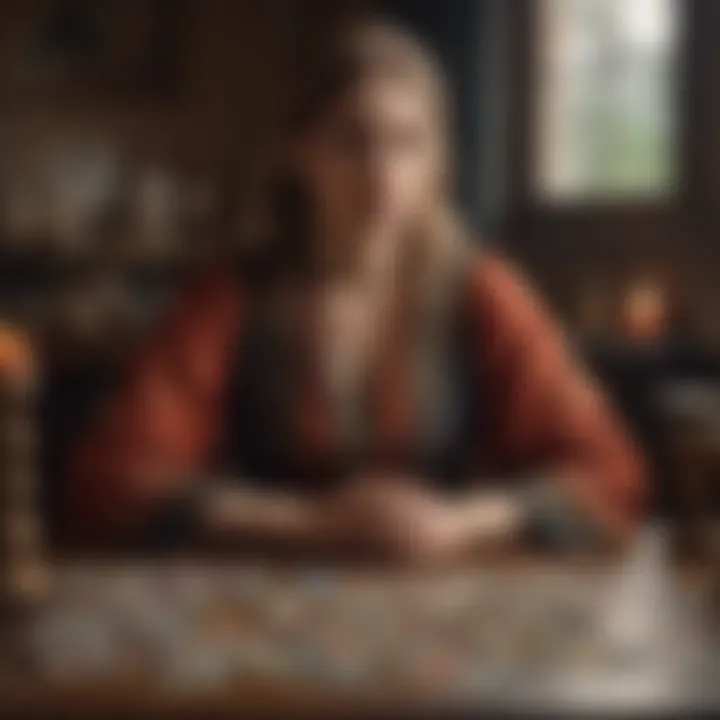
Many people may approach tarot expecting concrete answers. Yet, it often opens discussions rather than providing definitive conclusions. Users can discover deeper aspects of their lives through tarot's symbolic language. It is essential to emphasize that tarot is a tool for reflection, aiding individuals in understanding themselves and their scenarios without binding them to a singular interpretation.
"Tarot cards encourage exploration of one's thoughts and feelings, rather than serving as a strict judgment on future events."
The Influence of the Reader
The role of the tarot card reader is paramount in shaping the experience and outcome of a tarot reading. This influence manifests through various channels, including the reader's intentions, emotional state, and skill set. Each of these elements can significantly affect not only the interpretation of the cards but also the overall experience for the querent, the person seeking insight. Understanding these influences offers deeper insight into the practice of tarot and encourages a more nuanced view of its effectiveness.
The Reader's Intention
Intention is a powerful aspect in tarot reading. When a reader approaches a session with a clear, positive intention, it sets the stage for an insightful experience. This intention can guide the interpretations made during the reading. For example, if a reader focuses on empowering the querent, the insights provided may emphasize self-agency and possibilities.
On the contrary, if a reader brings doubts or negative feelings into the reading, this may cloud their judgment and impact how they perceive the cards. The intention not only affects the reader but also resonates with the querent, influencing their perception of the reading’s outcome.
- The following factors can shape the reader's intention:
- Personal beliefs about tarot
- The emotional state prior to the reading
- The specific question posed by the querent
A focused intention can create a supportive atmosphere that helps the querent feel seen and heard, engaging them more deeply in the process. This engagement further enhances a person's ability to extract insights from the reading.
Skills and Experience of the Reader
The skills and experience of the tarot reader are critical components in the efficacy of the reading. Each reader develops a unique style over time, influenced by their training, experiences, and personal approaches to tarot. The depth of knowledge regarding card meanings, symbolism, and spreads can greatly impact the quality of interpretation.
More experienced readers often exhibit the following characteristics:
- A developed intuition that guides their reading
- The ability to form connections between various cards in a spread
- Proficient communication skills that clarify and articulate insights
Furthermore, an experienced reader is often more adept at recognizing the querent's needs. They may use their background knowledge in psychology or other holistic practices to provide a richer context for the reading.
"The reader’s intuition combined with their technical skills can transform a simple card reading into a profound experience for the querent."
In summary, both the reader’s intention and their expertise significantly influence the tarot reading process. These aspects contribute to how effective the cards can be in providing clarity and insight.
Ethical Considerations in Tarot Reading
The practice of tarot reading, while often surrounded by mystique, carries significant ethical responsibilities. This segment addresses the weight and relevance of ethical conduct in tarot reading, focusing on how the reader's decisions affect the querent, the individual seeking guidance. Ethically sound practices can foster a safe and respectful environment, encouraging the querent to engage more openly and honestly.
Tarot reading can impact a person’s life path, often leading to transformative insights. However, this also means that readers have a duty to exercise their skills judiciously. An ethical approach not only bolsters the integrity of tarot as a practice but also enhances the trust between the reader and querent. This reciprocal relationship thrives on mutual respect and understanding.
Respect for the Querent
Respecting the querent is paramount in any tarot reading session. This includes honoring their feelings, beliefs, and personal boundaries. Readers must recognize that clients often present themselves in vulnerable states, seeking comfort, guidance, and clarity about their situations. It is essential to create a safe space where querents feel empowered to share their stories without fear of judgment.
- Active Listening: Truly hearing what a querent says can lead to more insightful interpretations of the cards. It demonstrates that their concerns are valued.
- Non-Judgmental Attitude: A reader should maintain neutrality, acknowledging that each individual's experiences and choices are their own.
- Confidentiality: Information shared during a session must be kept private. This confidentiality builds rapport and encourages the querent to delve deeper into their issues, facilitating a more meaningful reading.
Transparency and Responsibility
Transparency is another crucial ethical element in tarot reading. Readers should be upfront about their methods, the limitations of tarot as a tool, and what clients might realistically expect from a session. Misrepresentation can lead to disillusionment and skepticism regarding tarot.
- Clear Communication: Before a session begins, readers should explain how the process works and what cards can and cannot tell. This demystifies the experience and aligns expectations.
- Acknowledging Limitations: Tarot does not hold absolute answers or guarantees about the future. Readers should invoke caution and encourage querents to use the insights gained as guidance rather than definitive predictions.
- Empowerment Over Dependency: The aim should be to empower querents in their journeys, rather than fostering a sense of dependency on repeated readings. Offering tools for self-reflection is essential here.
Closure: Do Tarot Cards Really Work?
The inquiry into the validity of tarot cards presents a complex landscape involving historical, psychological, and cultural dimensions. Throughout this article, we have highlighted various aspects of tarot reading, establishing a framework for understanding its potential benefits and limitations. Evaluating tarot's efficacy is not merely an academic exercise; it has implications for those seeking guidance and reflection in their lives.
Final Thoughts on Efficacy
The efficacy of tarot cards often hinges on the individual’s perspective and intention. For many, tarot serves as a valuable tool for introspection and self-discovery. It allows querents to dive into their subconscious, exploring emotions and thoughts they may not fully articulate. However, interpretations can vary greatly, influenced by the reader's skills, the querent's mindset, and the context of the reading.
Research suggests that much of the effectiveness of tarot may derive from cognitive biases, such as confirmation bias. Clients might recall only the accurate predictions or resonate with the insights that align with their desires. This subjective experience complicates the argument for or against tarot's legitimacy; thus, while it can provide clarity or perspective, it should not be seen as an infallible method for predicting the future.
Future Directions for Research and Practice
As the conversation surrounding tarot continues, further investigation may deepen our understanding of its role as a reflective practice. Studies could explore its psychological impact and the neurological processes involved during a reading. Additionally, interdisciplinary research might enrich our comprehension of the cultural significance of tarot in different societies.
Practitioners are encouraged to maintain an ethical approach, respecting the querents' autonomy while offering guidance rooted in evidence and compassion. Further exploration into the integration of tarot with therapeutic practices could yield beneficial outcomes, potentially establishing a framework for its utilization in psychology and holistic life approaches.
In summary, while tarot cards are unlikely to yield universally accepted scientific validation, their value as a tool for reflection may validate their continued use in contemporary society. As we progress, a balanced perspective that combines personal experience with empirical study will enhance the discourse surrounding tarot's role in our lives.



